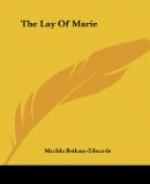And heavy were
De Stafford’s sighs,
And oft impatient would they
rise;
Though Friendship, Honour’s
self was there,
Until he found a nurse more
fair!
A nicer tact, a finer skill,
To know and to perform his
will—
Until he felt the healing
look,
The tones that only Marie
spoke!
How patient, then,
awaiting ease,
And suffering pain, he cross’d
the seas!
How patient, when they reach’d
the shore,
A long, long tract he journey’d
o’er!
Though days and months flow’d
past, at length,
Ere he regain’d his
former strength,
He yet had courage to sustain,
Without a murmur, every pain!
“At home once more—with
friends so true—
My boy recover’d thus”—he
cried,
“His mother smiling
by my side—
Resigned each lesser ill I
view!
As bubbles on the Ocean’s
breast,
When gloriously calm, will
rise;
As shadows from o’er-clouded
skies,
Or some few angry waves may
dance
Nor ruffle that serene expanse;
So lightly o’er my comfort
glides
Each adverse feeling—so
subsides
Each discontent—and
leaves me blest!”
NOTES.
NOTE I.
The Lay of Marie.—Title.
The words roman, fabliau, and lai, are so often used indifferently by the old French writers, that it is difficult to lay down any positive rule for discriminating between them. But I believe the word roman particularly applies to such works as were to be supposed strictly historical: such are the romances of Arthur, Charlemagne, the Trojan War, &c. The fabliaux were generally, stories supposed to have been invented for the purpose of illustrating some moral; or real anecdotes, capable of being so applied. The lai, according to Le Grand, chiefly differed from the fabliau, in being interspersed with musical interludes; but I suspect they were generally translations from the British. The word is said to be derived from leudus; but laoi seems to be the general name of a class of Irish metrical compositions, as “Laoi na Seilge” and others, quoted by Mr. Walker (Hist. Mem. of Irish Bards), and it may be doubted whether the word was not formerly common to the Welsh and American dialects.—Ellis’s Specimens.
The conclusion of Orfeo and Herodiis, in the Auchinlech MS, seems to prove that the lay was set to music:
That lay Orfeo is yhote,
Gode is the lay, swete is
the note.
In Sir Tristrem also, the Irish harper is expressly said to sing to the harp a merry lay.
It is not to be supposed, what we now call metrical romances were always read. On the contrary, several of them bear internal evidence that they were occasionally chaunted to the harp. The Creseide of Chaucer, a long performance, is written expressly to be read, or else sung. It is evident that the minstrels could derive no advantage from these compositions, unless by reciting or singing them; and later poems have been said to be composed to their tunes.—Notes to Sir Tristrem.




